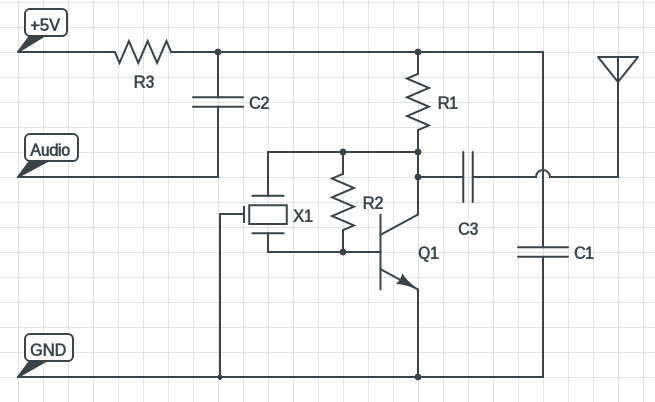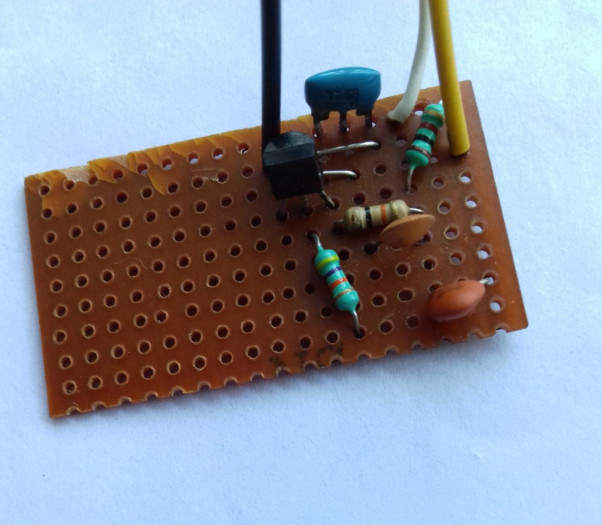So, if you're looking for the the simplest and cheapest shortwave transmitter circuit, it's here.
This transmitter is very low power and very stable as well, uses a readily available 3 terminal ceramic resonator to set the frequency.
Though this shortwave transmitter circuit can reach barely around 5 meters, but you can be increase the range easily with a simple RF amplifier and a low pass filter stage. Lets get started...
Contents
Simplest shortwave transmitter circuit diagram
Lets have a look at the circuit diagram,

Just one transistor and a 10.7 MHz ceramic resonator with few other passive components !
Part list
Below the part list,
- Q1 - BC548 or any quivalent NPN transistor
- X1 - 10.7 MHz ceramic resonator, 3 terminal
- C1 - 10 nF ceramic disc capacitor (103)
- C2 - 100 nF ceramic disc capacitor (104)
- C3 - 100 pF ceramic disc capacitor (101)
- R1 - 10 kOhm
- R2 - 150 kOhm
- R3 - 1 kOhm
That's all you need to make this shortwave transmitter circuit . Power up the circuit with a clean 3 V to 5 V DC supply, i.e with a single Li-Ion battery is.
You can also replace the 10.7 MHz ceramic resonator with any other between 2.3 MHz to 26 MHz range.
Construction and testing
It's quite easy to build, but you shouldn't use a breadboard. I've built a prototype on a little piece of strip board.

A little about the audio input, you cant just connect a microphone to the audio input. This transmitter circuit needs a amplified signal input, should be powerful enough to modulate the amplitude.
Antenna plays a vital role on the range of this shortwave transmitter, without an antenna it won't go more than one meter. Antenna length is not critical just connect a piece of 1 meter wire.
The frequency can be changed a a little(0.1-0.2 MHz) by adding a capacitor in series with the ceramic resonator.
What is the practical use of a 10.7 MHz radio transmitter? Moreover, the audio input requires pre-amplification which is going to add more circuitry and the circuit no longer remains "The Simplest" shortwave transmitter. But from an academic point of view, this is an excellent project for students.
Well, I'm making a 300bps full duplex ASK modulated RF serial data link, that's the practical use.
Hi Arnab, that's a very intelligent answer indeed, I' impressed!
By the way, why not give a little more details about your project for the benefit of interested hobbyists here? And when you complete your serial data link project, please do post a few pictures and article on how to make it. No offence intended 🙂
Absolutely ! I'll write a detailed tutorial about the serial data transceiver, I want to build something like LoRaWAN.
Currently stuck with the receiver part, it's not stable.
Sorry to know about the instability of receiver! Why not try PLL? Cheap IC's are available to implement simple PLL based receivers.
Dear sir
I want to connect charger of LAN switch with 220 V Dc in place of AC is it possible? I have not seen any Transformer in charger.
Or plz guide for any ckt which convert 220v dc to 5-9 VDc
So I tried to build this and it doesn't seem to be working.
Here is an imgur album of the schematic, cad file, and final result pictures.
http://imgur.com/a/4EGqZ
I used a 8mhz resonator, a 2N2222A NPN transistor, and various other resistors and transistors. I replaced R2 with a 100 ohm and 50 ohm resistor in series (due to part availibility) and I replaced C1 with 10 1000pf (10nf total) capacitors. I wired both the left and right (white and red) audio channels of an AUX cable to the audio line.
Also, the trace I had going under C3 didn't mill correctly, so I used a piece of wire as a jumper (seen going over C3).
I tried powering the circuit off a 9V battery and then 5V from the usb port of my laptop.
When my shortwave receiver is tuned to 8mhz, there is noisy static. When the power is connected to the transmitter, there is quite. However, when I try to play any sound from my laptop connected via the AUX cord, no sound is made. When I press my finger to various parts of the circuit (the top of the transistor, the antenna and the collector side of the resonator) there is a loud buzzing noise from the receiver.
Since I don't know exactly how this circuit works, I'm not sure what exactly could be wrong with it. I thought that maybe there is stray capacitance from the traces, but I don't know if that is significant enough to have an impact.
Any help would be greatly appreciated. I am making this so that I can use the short wave receiver as a functional prop for a presentation in my literature class.
Thanks.
Oh, I forgot to include that I also tested the circuit with a wave generator. I used a 10kHz sine wave on the audio line. Since I didn't have the short wave radio to test if it was transmitting, I hooked the antenna line up to an oscilloscope. The sine wave was not evident in the reading on the oscilloscope, but something (I presume the 8mhz clock) did display.
Thanks.
Perhaps the 10kHz sine wave was not powerful enough(as it was coming from a signal generator) to induce a meaningful modulation.
Thanks Owen for the comment.
You don't need the exact component values, C1 could be anything between 10nF to 100nF, C3 is also not critical.
And you should always power up the transmitter from a battery, perhaps 9 volt is a bit higher, but I was getting the signals even when using 9V battery. An old cellphone battery is best.
Thanks for the reply.
I swapped the row of 10 capacitors with a single 100nF capacitor. It works now. I was able to hear the signals from the transmitter when I used the wave generator to make a wave. I'm using an input voltage of 9V and an audio voltage of 5V at peak.
However, when I play sound through the transmitter with the AUX cord I have attached, it is very quiet. How can I make the broadcast louder?
Thanks.
Update: I swapped C2 with a 1uF capacitor instead of the 100nF capacitor. It works great now. Also, I have C1 as 100 nF, not 10nF.
How would i replace the ceramic resonator with a crystal and two capacitors.Thanks.
great artical sir